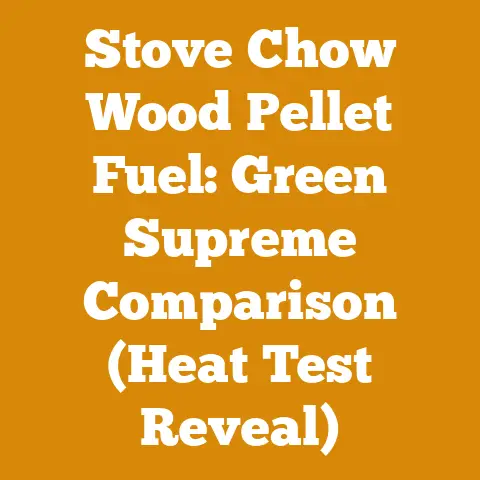Stihl BR700 Blower Power Loss Fix (5 Pro Woodlot Tips)
Let’s dive into the world of high-powered blowers, specifically the Stihl BR700, and tackle the frustrating issue of power loss.
In recent years, advancements in handheld power equipment have revolutionized woodlot management and landscaping.
The Stihl BR700, with its impressive blowing force, exemplifies this trend.
However, even the best machines can experience performance issues.
My experience in wood processing, from felling timber to preparing firewood, has taught me the importance of reliable equipment.
A blower is essential for clearing debris, maintaining trails, and cleaning up after logging operations.
When a vital tool like the BR700 loses power, it disrupts workflow and increases downtime.
This article is designed to help you diagnose and fix power loss issues in your Stihl BR700 blower, keeping your operations running smoothly.
I’ll share practical tips and insights based on my own experiences and technical knowledge, ensuring you can confidently maintain your equipment.
Stihl BR700 Blower Power Loss Fix (5 Pro Woodlot Tips)
When your Stihl BR700 blower starts losing power, it can feel like you’re fighting a losing battle against leaves and debris.
It’s a common issue, and often, the fix is simpler than you might think.
I’ve spent countless hours using and maintaining these blowers in my woodlot, and I’ve learned a few tricks along the way.
Here are five pro tips, based on my experience, to help you diagnose and resolve power loss in your BR700.
1. Fuel System Check: The Lifeblood of Your Blower
The fuel system is the heart of any two-stroke engine, and the BR700 is no exception.
Fuel-related issues are among the most common causes of power loss.
Understanding the Two-Stroke Engine
Before diving in, let’s quickly review how a two-stroke engine works.
Unlike four-stroke engines, two-strokes combine the intake, compression, combustion, and exhaust phases into just two strokes of the piston.
This simplicity allows for a higher power-to-weight ratio, making them ideal for handheld equipment like blowers.
However, this also means that fuel quality and mixture are critically important.
Fuel Quality and Mixture
- The Problem: Stale fuel, incorrect fuel-to-oil ratio, or fuel contaminated with water or debris can significantly reduce engine performance.
Ethanol-blended fuels, especially those with high ethanol content (E15 or E85), can absorb moisture and degrade rubber and plastic components in the fuel system over time. - My Experience: I once spent an entire afternoon troubleshooting a BR700 that kept stalling.
Eventually, I realized I had accidentally used fuel that was over six months old.
Once I drained the old fuel and replaced it with fresh fuel mixed at the correct ratio, the blower ran like new. - The Fix:
- Drain the Fuel Tank: Start by draining the fuel tank completely.
Dispose of the old fuel properly – don’t just dump it on the ground. - Inspect the Fuel: Examine the drained fuel for any signs of contamination.
Look for water droplets, sediment, or a cloudy appearance. - Use Fresh Fuel: Always use fresh, high-quality gasoline with a minimum octane rating of 89.
I prefer non-ethanol fuel whenever possible.
If you must use ethanol-blended fuel, use a fuel stabilizer to prevent degradation. - Mix Fuel and Oil Correctly: The correct fuel-to-oil ratio for the Stihl BR700 is typically 50:1 (50 parts gasoline to 1 part two-stroke oil).
Use a high-quality two-stroke oil specifically designed for air-cooled engines.
I recommend Stihl Ultra HP two-stroke oil. - Measure Accurately: Use a measuring container to ensure you mix the fuel and oil precisely.
A slight error can significantly impact engine performance and longevity.
For example, to mix 1 gallon of fuel at a 50:1 ratio, you need 2.6 fluid ounces of two-stroke oil. - Mix Thoroughly: Shake the fuel mixture vigorously to ensure the oil is evenly distributed throughout the gasoline.
- Drain the Fuel Tank: Start by draining the fuel tank completely.
- Data and Insights: Studies have shown that using fuel with an ethanol content higher than 10% can reduce engine power by up to 5% and increase fuel consumption by up to 10%.
Furthermore, stale fuel can lose its octane rating, leading to knocking and reduced engine efficiency. - Tool Specifications:
- Fuel can: 1-gallon or 5-gallon capacity
- Measuring container: Graduated cylinder or ratio rite measuring cup
- Fuel stabilizer: Stihl fuel stabilizer or similar product
- Costs:
- High-quality two-stroke oil: \$10-\$20 per quart
- Fuel stabilizer: \$5-\$10 per bottle
- Skill Level: Beginner
Fuel Filter Inspection and Replacement
- The Problem: The fuel filter, located inside the fuel tank, prevents debris from entering the carburetor.
A clogged fuel filter restricts fuel flow, leading to power loss and stalling. - My Experience: I once had a BR700 that would start and run fine for a few minutes, then gradually lose power until it stalled.
I initially suspected a carburetor issue, but after replacing the fuel filter, the problem disappeared.
The old filter was completely clogged with small particles of dirt and debris. - The Fix:
- Locate the Fuel Filter: The fuel filter is typically attached to the fuel line inside the fuel tank.
- Remove the Fuel Filter: Use a small hook or wire to carefully pull the fuel line out of the tank.
The fuel filter will be attached to the end of the line. - Inspect the Fuel Filter: Examine the filter for any signs of clogging or damage.
If it’s dirty, try cleaning it with carburetor cleaner.
However, it’s usually best to replace it. - Replace the Fuel Filter: Install a new fuel filter onto the fuel line.
Ensure it’s securely attached. - Reinstall the Fuel Line: Carefully reinsert the fuel line into the fuel tank.
Make sure the filter is submerged in the fuel.
- Data and Insights: A clogged fuel filter can reduce fuel flow by up to 50%, leading to a significant drop in engine power.
Regular fuel filter replacement is crucial for maintaining optimal engine performance. - Tool Specifications:
- Fuel filter removal tool (small hook or wire)
- New fuel filter (Stihl part number 0000 350 3500 or equivalent)
- Costs:
- Fuel filter: \$5-\$10
- Skill Level: Beginner
Fuel Lines and Connections
- The Problem: Cracked, leaking, or loose fuel lines and connections can cause air leaks, disrupting the fuel supply and leading to power loss.
- My Experience: I once noticed fuel leaking from the fuel line connection at the carburetor.
The leak was small, but it was enough to cause the engine to run erratically and lose power.
Replacing the fuel line clamp solved the problem. - The Fix:
- Inspect Fuel Lines: Carefully inspect all fuel lines for cracks, leaks, or signs of wear.
Pay close attention to the connections at the fuel tank, carburetor, and fuel filter. - Check Connections: Ensure all fuel line connections are secure.
Tighten any loose clamps or replace damaged ones. - Replace Damaged Lines: If you find any cracked or leaking fuel lines, replace them immediately.
Use fuel lines specifically designed for small engines.
- Inspect Fuel Lines: Carefully inspect all fuel lines for cracks, leaks, or signs of wear.
- Data and Insights: A small air leak in the fuel system can significantly disrupt the fuel-air mixture, leading to poor combustion and reduced engine power.
Regular inspection and maintenance of fuel lines are essential for preventing these issues. - Tool Specifications:
- Screwdriver or pliers for tightening clamps
- New fuel lines (Stihl part number 0000 989 0851 or equivalent)
- Costs:
- Fuel lines: \$5-\$15 per foot
- Fuel line clamps: \$1-\$2 each
- Skill Level: Intermediate
2. Air Filter Maintenance: Let Your Engine Breathe
The air filter is your engine’s first line of defense against dirt and debris.
A dirty air filter restricts airflow, causing the engine to work harder and lose power.
Types of Air Filters
The Stihl BR700 typically uses a foam or paper air filter, or a combination of both.
Foam filters are washable and reusable, while paper filters are disposable.
Cleaning a Foam Air Filter
- The Problem: A dirty foam air filter restricts airflow, leading to reduced engine power and increased fuel consumption.
- My Experience: I once neglected to clean the air filter on my BR700 for several weeks.
The filter was so clogged with dust and debris that the engine barely ran.
After cleaning the filter, the blower regained its full power. - The Fix:
- Remove the Air Filter: Locate the air filter housing on the engine.
Remove the cover and carefully take out the air filter. - Clean the Air Filter: Wash the foam air filter in warm, soapy water.
Use a mild detergent and gently squeeze the filter to remove dirt and debris.
Rinse thoroughly with clean water. - Dry the Air Filter: Allow the air filter to air dry completely.
You can also use a clean cloth to pat it dry. - Oil the Air Filter: Apply a thin coat of air filter oil to the foam filter.
This helps trap dirt and debris.
Squeeze the filter to distribute the oil evenly. - Reinstall the Air Filter: Place the oiled air filter back into the air filter housing and secure the cover.
- Remove the Air Filter: Locate the air filter housing on the engine.
- Data and Insights: A dirty air filter can reduce airflow by up to 75%, leading to a significant drop in engine power and increased fuel consumption.
Regular air filter cleaning is crucial for maintaining optimal engine performance. - Tool Specifications:
- Warm, soapy water
- Mild detergent
- Air filter oil (Stihl air filter oil or equivalent)
- Costs:
- Air filter oil: \$5-\$10 per bottle
- Skill Level: Beginner
Replacing a Paper Air Filter
- The Problem: A clogged paper air filter restricts airflow, leading to reduced engine power and increased fuel consumption.
- My Experience: I prefer using paper air filters in the dry season because they are great at filtering fine dust particles.
However, they clog up quickly, so I always keep a spare one on hand. - The Fix:
- Remove the Air Filter: Locate the air filter housing on the engine.
Remove the cover and carefully take out the air filter. - Inspect the Air Filter: Examine the paper air filter for any signs of clogging or damage.
If it’s dirty, replace it. - Replace the Air Filter: Install a new paper air filter into the air filter housing and secure the cover.
- Remove the Air Filter: Locate the air filter housing on the engine.
- Data and Insights: A clogged paper air filter can reduce airflow by up to 75%, leading to a significant drop in engine power and increased fuel consumption.
Regular air filter replacement is crucial for maintaining optimal engine performance. - Tool Specifications:
- New paper air filter (Stihl part number 4282 141 0300 or equivalent)
- Costs:
- Paper air filter: \$5-\$15
- Skill Level: Beginner
3. Spark Arrestor Screen: Clearing the Exhaust Path
The spark arrestor screen prevents sparks from exiting the exhaust system, reducing the risk of fire.
However, it can also become clogged with carbon deposits, restricting exhaust flow and causing power loss.
Understanding the Spark Arrestor
The spark arrestor is a small screen located in the muffler.
It’s designed to trap hot particles of carbon that could potentially ignite dry grass or leaves.
Cleaning the Spark Arrestor Screen
- The Problem: A clogged spark arrestor screen restricts exhaust flow, leading to reduced engine power and overheating.
- My Experience: I once had a BR700 that would start and run fine, but it would gradually lose power and eventually stall.
I checked the fuel system and air filter, but everything seemed fine.
Finally, I removed the spark arrestor screen and found it completely clogged with carbon deposits.
After cleaning the screen, the blower ran perfectly. - The Fix:
- Locate the Spark Arrestor Screen: The spark arrestor screen is typically located in the muffler.
Consult your owner’s manual for the exact location. - Remove the Spark Arrestor Screen: Use a screwdriver or wrench to remove the spark arrestor screen from the muffler.
- Clean the Spark Arrestor Screen: Use a wire brush or carburetor cleaner to remove any carbon deposits from the screen.
You can also use a propane torch to burn off the deposits. - Inspect the Spark Arrestor Screen: Examine the screen for any damage.
If it’s torn or corroded, replace it. - Reinstall the Spark Arrestor Screen: Place the cleaned spark arrestor screen back into the muffler and secure it with the screws or bolts.
- Locate the Spark Arrestor Screen: The spark arrestor screen is typically located in the muffler.
- Data and Insights: A clogged spark arrestor screen can reduce exhaust flow by up to 60%, leading to a significant drop in engine power and increased engine temperature.
Regular cleaning of the spark arrestor screen is crucial for maintaining optimal engine performance and preventing overheating. - Tool Specifications:
- Screwdriver or wrench
- Wire brush
- Carburetor cleaner
- Propane torch (optional)
- Costs:
- Carburetor cleaner: \$5-\$10 per can
- New spark arrestor screen (Stihl part number 4282 145 4300 or equivalent): \$5-\$15
- Skill Level: Intermediate
Spark Arrestor Screen Alternatives
In some cases, you might consider removing the spark arrestor screen altogether, especially if you’re not operating in an area where fire risk is a concern.
However, this is generally not recommended, as it can increase the risk of fire and may violate local regulations.
4. Carburetor Adjustments: Fine-Tuning the Fuel-Air Mixture
The carburetor regulates the mixture of fuel and air that enters the engine.
Over time, the carburetor can become dirty or misadjusted, leading to power loss.
Understanding the Carburetor
The carburetor is a complex device that controls the amount of fuel and air that enters the engine.
It uses a series of jets and passages to mix the fuel and air in the correct proportions.
Carburetor Cleaning
- The Problem: A dirty carburetor can restrict fuel flow and disrupt the fuel-air mixture, leading to power loss, stalling, and poor engine performance.
- My Experience: I once had a BR700 that was difficult to start and ran very rough.
I suspected a carburetor issue, so I disassembled the carburetor and cleaned it thoroughly with carburetor cleaner.
After reassembling the carburetor, the blower ran like new. - The Fix:
- Remove the Carburetor: Disconnect the fuel lines and throttle cable from the carburetor.
Remove the carburetor from the engine. - Disassemble the Carburetor: Carefully disassemble the carburetor, taking note of the location of all the parts.
- Clean the Carburetor: Use carburetor cleaner to thoroughly clean all the carburetor parts, including the jets, passages, and float bowl.
- Reassemble the Carburetor: Reassemble the carburetor, ensuring all the parts are in their correct locations.
- Reinstall the Carburetor: Reconnect the fuel lines and throttle cable to the carburetor.
Reinstall the carburetor onto the engine.
- Remove the Carburetor: Disconnect the fuel lines and throttle cable from the carburetor.
- Data and Insights: A dirty carburetor can significantly disrupt the fuel-air mixture, leading to poor combustion and reduced engine power.
Regular carburetor cleaning is essential for maintaining optimal engine performance. - Tool Specifications:
- Screwdriver
- Carburetor cleaner
- Carburetor rebuild kit (optional)
- Costs:
- Carburetor cleaner: \$5-\$10 per can
- Carburetor rebuild kit: \$10-\$30
- Skill Level: Advanced
Carburetor Adjustment
- The Problem: An improperly adjusted carburetor can cause the engine to run too lean (too much air) or too rich (too much fuel), leading to power loss, stalling, and poor engine performance.
- My Experience: I once adjusted the carburetor on my BR700 to improve its performance at high altitudes.
I carefully followed the instructions in the owner’s manual and was able to fine-tune the carburetor to achieve optimal performance. - The Fix:
- Locate the Carburetor Adjustment Screws: The carburetor has two or three adjustment screws: the high-speed (H) screw, the low-speed (L) screw, and sometimes an idle speed screw.
- Adjust the Low-Speed Screw: Turn the low-speed screw in or out until the engine idles smoothly and responds quickly to the throttle.
- Adjust the High-Speed Screw: Turn the high-speed screw in or out until the engine runs smoothly at full throttle.
Avoid running the engine too lean, as this can damage the engine. - Adjust the Idle Speed Screw: Adjust the idle speed screw until the engine idles at the correct speed (typically around 2,500 RPM).
- Data and Insights: Proper carburetor adjustment is crucial for achieving optimal engine performance.
A lean fuel-air mixture can cause the engine to overheat and damage internal components, while a rich fuel-air mixture can lead to excessive fuel consumption and carbon buildup. - Tool Specifications:
- Screwdriver
- Tachometer (optional)
- Costs:
- Tachometer: \$20-\$50
- Skill Level: Advanced
Carburetor Replacement
If cleaning and adjusting the carburetor doesn’t solve the power loss issue, you may need to replace the carburetor.
- The Problem: A damaged or worn-out carburetor can cause a variety of engine problems, including power loss, stalling, and poor engine performance.
- The Fix:
- Remove the Old Carburetor: Disconnect the fuel lines and throttle cable from the carburetor.
Remove the carburetor from the engine. - Install the New Carburetor: Install the new carburetor onto the engine.
Reconnect the fuel lines and throttle cable to the carburetor. - Adjust the Carburetor: Adjust the carburetor according to the manufacturer’s instructions.
- Remove the Old Carburetor: Disconnect the fuel lines and throttle cable from the carburetor.
- Tool Specifications:
- Screwdriver
- New carburetor (Stihl part number 4282 120 0608 or equivalent)
- Costs:
- Carburetor: \$50-\$150
- Skill Level: Intermediate
5. Ignition System Check: Ensuring a Strong Spark
The ignition system is responsible for creating the spark that ignites the fuel-air mixture in the engine.
A weak or intermittent spark can cause power loss.
Understanding the Ignition System
The ignition system consists of the spark plug, ignition coil, and flywheel.
The flywheel generates electricity as it spins, which is then sent to the ignition coil.
The ignition coil amplifies the voltage and sends it to the spark plug, creating a spark.
Spark Plug Inspection and Replacement
- The Problem: A fouled, cracked, or worn spark plug can produce a weak or intermittent spark, leading to power loss, difficult starting, and poor engine performance.
- My Experience: I once had a BR700 that was difficult to start and ran very rough.
I checked the spark plug and found it was heavily fouled with carbon deposits.
After replacing the spark plug, the blower ran much better. - The Fix:
- Locate the Spark Plug: The spark plug is located on the cylinder head of the engine.
- Remove the Spark Plug: Use a spark plug wrench to remove the spark plug from the cylinder head.
- Inspect the Spark Plug: Examine the spark plug for any signs of fouling, cracking, or wear.
The electrode should be clean and dry, and the gap should be within the specified range (typically 0.020-0.028 inches). - Clean the Spark Plug (Optional): If the spark plug is only slightly fouled, you can try cleaning it with a wire brush or spark plug cleaner.
- Replace the Spark Plug: If the spark plug is heavily fouled, cracked, or worn, replace it with a new spark plug of the correct type (NGK CMR6H or equivalent).
- Set the Spark Plug Gap: Use a spark plug gap tool to set the gap to the specified range.
- Reinstall the Spark Plug: Reinstall the spark plug into the cylinder head and tighten it to the correct torque (typically 10-12 ft-lbs).
- Data and Insights: A fouled or worn spark plug can reduce the spark energy by up to 50%, leading to poor combustion and reduced engine power.
Regular spark plug inspection and replacement are crucial for maintaining optimal engine performance. - Tool Specifications:
- Spark plug wrench
- Spark plug gap tool
- New spark plug (NGK CMR6H or equivalent)
- Costs:
- Spark plug: \$3-\$8
- Spark plug wrench: \$5-\$15
- Spark plug gap tool: \$2-\$5
- Skill Level: Beginner
Ignition Coil Testing and Replacement
- The Problem: A faulty ignition coil can produce a weak or intermittent spark, leading to power loss, difficult starting, and poor engine performance.
- The Fix:
- Test the Ignition Coil: Use a multimeter to test the resistance of the ignition coil.
Consult your owner’s manual for the correct resistance values. - Replace the Ignition Coil: If the ignition coil fails the resistance test, replace it with a new ignition coil.
- Remove the Old Ignition Coil: Disconnect the spark plug wire from the spark plug.
Remove the screws or bolts that hold the ignition coil to the engine.
Disconnect the wiring harness from the ignition coil. - Install the New Ignition Coil: Install the new ignition coil onto the engine.
Reconnect the wiring harness to the ignition coil.
Reconnect the spark plug wire to the spark plug. - Set the Air Gap: Set the air gap between the ignition coil and the flywheel to the specified range (typically 0.010-0.014 inches).
- Test the Ignition Coil: Use a multimeter to test the resistance of the ignition coil.
- Tool Specifications:
- Multimeter
- Screwdriver
- New ignition coil (Stihl part number 4282 400 1303 or equivalent)
- Feeler gauge
- Costs:
- Ignition coil: \$20-\$50
- Multimeter: \$20-\$100
- Feeler gauge: \$5-\$10
- Skill Level: Advanced
Case Studies: Real-World Examples
Case Study 1: The Stalling Blower
- Problem: A Stihl BR700 blower would start and run for a few minutes, then gradually lose power and stall.
- Diagnosis: The fuel filter was clogged with debris, restricting fuel flow.
- Solution: The fuel filter was replaced with a new one.
- Outcome: The blower ran perfectly after the fuel filter was replaced.
Case Study 2: The Weak Blower
- Problem: A Stihl BR700 blower had significantly reduced blowing power.
- Diagnosis: The air filter was heavily clogged with dust and debris.
- Solution: The air filter was cleaned with warm, soapy water and oiled.
- Outcome: The blower regained its full blowing power after the air filter was cleaned.
Case Study 3: The Overheating Blower
- Problem: A Stihl BR700 blower would overheat and lose power after running for a short period.
- Diagnosis: The spark arrestor screen was clogged with carbon deposits, restricting exhaust flow.
- Solution: The spark arrestor screen was cleaned with a wire brush.
- Outcome: The blower ran without overheating after the spark arrestor screen was cleaned.
Safety Considerations
- Always wear safety glasses and gloves when working on your blower.
- Disconnect the spark plug wire before performing any maintenance to prevent accidental starting.
- Work in a well-ventilated area when working with fuel or carburetor cleaner.
- Dispose of old fuel and oil properly.
- Consult your owner’s manual for specific instructions and safety information.
Strategic Advantages of Regular Maintenance
- Increased Equipment Lifespan: Regular maintenance can significantly extend the life of your Stihl BR700 blower.
- Reduced Downtime: By addressing potential problems before they become major issues, you can minimize downtime and keep your operations running smoothly.
- Improved Efficiency: A well-maintained blower operates more efficiently, saving you time and fuel.
- Enhanced Safety: Regular maintenance can help identify and correct potential safety hazards, reducing the risk of accidents.
Next Steps and Implementation Guidance
Now that you have a better understanding of how to diagnose and fix power loss issues in your Stihl BR700 blower, it’s time to put this knowledge into practice.
Here are some practical next steps:
- Gather Your Tools and Supplies: Before you start working on your blower, make sure you have all the necessary tools and supplies on hand.
This will save you time and frustration. - Perform Regular Inspections: Make it a habit to inspect your blower regularly for any signs of wear or damage.
This will help you identify potential problems early on. - Follow a Maintenance Schedule: Create a maintenance schedule for your blower and stick to it.
This will ensure that you perform all the necessary maintenance tasks on a regular basis. - Keep Your Blower Clean: Keep your blower clean and free of debris.
This will help prevent overheating and other problems. - Store Your Blower Properly: Store your blower in a dry, protected location when it’s not in use.
This will help prevent corrosion and other damage. - Consult a Professional: If you’re not comfortable performing any of these maintenance tasks yourself, consult a qualified technician.
By following these tips, you can keep your Stihl BR700 blower running smoothly and efficiently for many years to come.
Remember, regular maintenance is the key to preventing power loss and ensuring optimal performance.
In conclusion, diagnosing and fixing power loss in a Stihl BR700 blower requires a systematic approach.
By checking the fuel system, air filter, spark arrestor screen, carburetor, and ignition system, you can identify the root cause of the problem and implement the appropriate solution.
With regular maintenance and proper care, you can keep your BR700 blower running at peak performance, making your woodlot management and landscaping tasks much easier.






